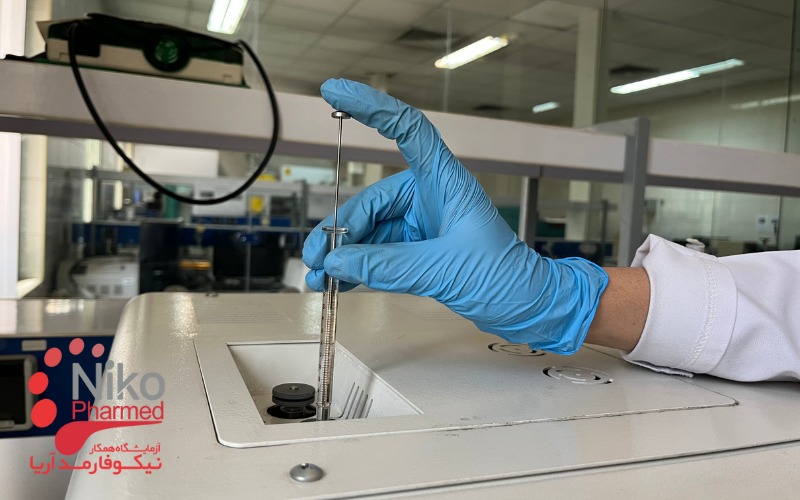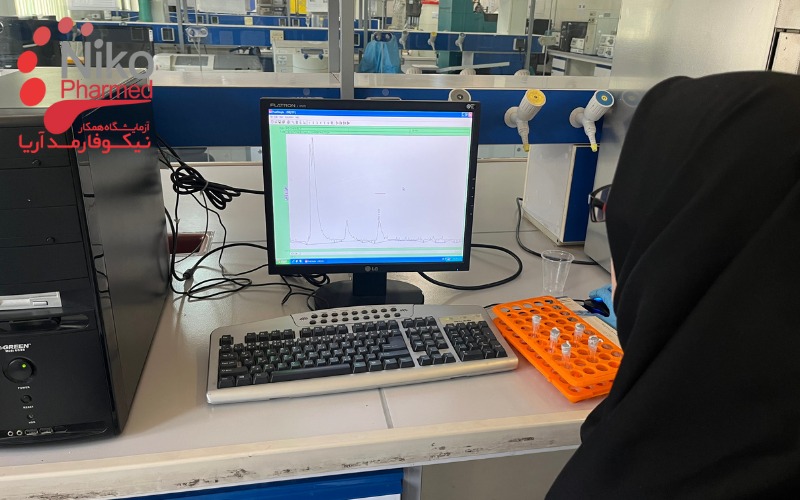What is Ethylene Oxide (EO) residual Testing?
Ethylene Oxide (EO) Residual testing is a critical assessment used to quantify the levels of ethylene oxide, ethylene chlorohydrin (ECH), and ethylene glycol (EG) that may remain on or within a medical device following EO sterilization.
The objective of this standard is to protect patients from systemic toxicity, local irritation, and sensitization caused by residual sterilant and its by-products. EO, while effective for sterilizing heat- and moisture-sensitive medical devices, is a toxic, mutagenic, and potentially carcinogenic compound; therefore, its residual levels must be tightly controlled and monitored. Residual EO data are integrated into the overall biocompatibility testing programme, providing quantitative exposure inputs for the biological risk assessment and supporting regulatory submissions.
Regulatory Basis and Scope
ISO 10993-7 provides a risk-based approach for:
Determining permissible limits for EO, ECH, and EG based on daily exposure assumptions;
Designing and validating extraction and analytical methods for accurate quantification;
Establishing acceptable residual levels through toxicological risk assessment for both short-term and long-term use medical devices.
The standard supports global regulatory submissions, including those to the U.S. FDA, EU MDR, and other international bodies, and is intended to be used in conjunction with ISO 11135 (EO sterilization validation).
Testing Methodology
Testing involves:
Extraction or desorption of EO from the finished device using headspace gas chromatography (GC) or direct thermal desorption.
Quantification of EO, ECH, and EG using validated analytical methods, often based on ISO 10993-12 for sample preparation.
Simulation of worst-case conditions, including product configuration, packaging, and sterilization parameters.
Calculation of maximum patient exposure based on device use scenario and surface area/contact time assumptions.
Batch release testing may also be required for EO-sterilized devices with potential high residuals.
Risk Assessment and Compliance
The results of residual EO testing must be interpreted in the context of:
Total daily patient exposure (single or multiple device use)
Toxicological thresholds based on validated TTC (Threshold of Toxicological Concern)
Integration into the overall biological risk assessment under ISO 10993-1
Devices exceeding permissible limits must undergo further aeration, requalification, or redesign of sterilization cycles to achieve compliance.
Residual EO gas testing under ISO 10993-7 is an essential safety and regulatory requirement for EO-sterilized medical devices. It ensures that residual levels of EO and its by-products do not pose unacceptable risks to patients. Through robust analytical testing, toxicological evaluation, and compliance with defined exposure limits, manufacturers can demonstrate that their products are both safe for clinical use and ready for global regulatory acceptance.
For parenteral drugs, biologics and implantable devices, EO residual limits are typically evaluated with Pyrogen Testing and Bacterial Endotoxin Testing (BET) to demonstrate that both chemical sterilant residues and pyrogenic contaminants are controlled within an integrated safety and biocompatibility package.
Residual Ethylene Oxide Gas Testing Laboratory
Accreditation and Global Recognition
International Nikopharmad Laboratory proudly holds ISO/IEC 17025 certification and ILAC accreditation, confirming our competence in analytical testing and adherence to internationally recognized quality systems. These credentials ensure that our EO residual testing results are globally accepted by regulatory authorities.
Technical Excellence and Advanced Infrastructure
Our analytical chemistry laboratory is equipped with state-of-the-art gas chromatography (GC) systems, thermal desorption units, and validated extraction protocols tailored to ISO 10993-7 and ISO 10993-12. We quantify residual ethylene oxide (EO), ethylene chlorohydrin (ECH), and ethylene glycol (EG) with exceptional precision—supporting both routine release and worst-case evaluations.
We simulate clinically relevant conditions including packaging and device configuration, and provide toxicological risk assessments aligned with exposure thresholds defined in the standard. Our systems are validated for LOD/LOQ, linearity, recovery, and method robustness per GLP and ISO requirements.
Regulatory-Ready Reporting and Timely Results
Our efficient project workflows and rigorous QA oversight ensure that EO residual testing is delivered with speed, accuracy, and full traceability. Each study includes:
Validated method descriptions
Sample extraction and desorption parameters
Comprehensive toxicological exposure calculations
Daily exposure assessment for EO, ECH, and EG
Conformity to device contact duration (short-term or long-term)
Reports are structured for regulatory submission and formatted to meet FDA, MDR, and NMPA expectations, ensuring a smoother pathway through the compliance process.
Confidentiality and Data Integrity
Nikopharmad is committed to the highest standards of data security and client confidentiality. All device samples, analytical results, and proprietary information are handled in accordance with 21 CFR Part 11, strict IP protection protocols, and audit-ready documentation standards, ensuring full compliance with both regulatory and ethical requirements.
Competitive Pricing Without Compromising Scientific Quality
We recognize that cost-efficiency is essential in the competitive landscape of medical device development. That’s why Nikopharmad offers residual EO testing at highly competitive rates while maintaining rigorous scientific and regulatory standards. Whether you’re a startup or an established manufacturer, our pricing model is designed to support your time-to-market objectives and regulatory compliance strategy without sacrificing quality or credibility.
Partner with Nikopharmad for Your EO Residual Testing Needs
Choosing International Nikopharmad Laboratory means partnering with a proven, accredited laboratory specialized in Ethylene Oxide sterilant residual analysis. Our expertise in gas-phase toxicant quantification, regulatory toxicology, and submission-ready documentation makes us the strategic choice for manufacturers seeking global clearance for EO-sterilized products.
To request testing or a complimentary consultation contact Nikopharmad
Residual Ethylene Oxide Gas Testing Procedure
Test Objective and Permissible Exposure Limits
The primary goal of this testing is to ensure that residual sterilant gases and their by-products do not exceed the allowable daily exposure (ADE) limits established in the standard:
ISO 10993-7 defines two categories of exposure duration:
Limited Contact (≤24 hours)
Prolonged and Permanent Contact (>24 hours)
For each category, the standard specifies:
Allowable daily exposure (ADE) for EO:
4 mg/day for short-term exposure
0.1 mg/day for prolonged or permanent exposure
Similar toxicological limits exist for ECH and EG, with their own conversion factors and risk calculations.
Sample Selection and Preparation
Representative samples must be selected from the production lot or sterilization validation batch.
Devices must be tested in their final sterilized packaging, unless otherwise justified.
Testing should be conducted at the end of the claimed aeration period, when residual levels are at their highest within the accepted specification window.
For multilayer or complex devices, each component that contacts the patient should be evaluated.
Analytical Methods
Extraction or Desorption Method
Two approaches are recommended depending on the nature of the device and analyte:
Headspace gas chromatography (GC) – for volatile EO detection.
Solvent extraction – for ECH and EG analysis, often using water or a suitable solvent followed by chromatographic analysis.
The selected method must be:
Validated for recovery, linearity, precision, limit of detection (LOD), and limit of quantitation (LOQ).
Traceable to reference standards, with appropriate calibration curves and use of internal standards where applicable.
Aeration Simulation (if required)
If in-process aeration is incomplete or if additional aeration is simulated during validation, it must reflect real-world conditions (e.g., temperature, humidity, and duration) to ensure accurate estimation of residuals.
Exposure Calculation and Risk Assessment
The concentration of each residual is converted into an estimated patient exposure dose (mg/day) using one of the following models:
- Total EO content per device / number of uses per day
- Surface area-based exposure (e.g., mg/cm²) if applicable
This is then compared to the ADE threshold outlined in ISO 10993-7 to determine compliance. The assessment must consider:
The intended contact duration
Number of devices used per patient per day
Potential cumulative exposure
If exposure exceeds the ADE, a toxicological risk assessment or additional aeration measures are required before the device can be deemed biocompatible.
Documentation and Reporting
A comprehensive final report must include:
Device description, sterilization and aeration parameters
Sample preparation and test conditions
Analytical method validation data
Raw and processed results (e.g., chromatograms, calibration curves)
Calculation of daily patient exposure
Statement of compliance or non-compliance with ISO 10993-7 limits
The report should be suitable for inclusion in regulatory dossiers (e.g., FDA 510(k), EU MDR Technical File) and conform to applicable GLP or ISO 17025 requirements.
Why Does Ethylene Oxide Residue Remain After Sterilization?
Ethylene oxide (EO) is a low-temperature, gas-phase sterilant widely used for sterilizing heat- and moisture-sensitive medical devices, particularly those made of complex polymers, multilayer materials, or with intricate lumens. Despite its effectiveness, EO tends to leave residuals on or within the device post-sterilization. This occurs due to several interconnected reasons:
Physical Absorption into Polymers
Ethylene Oxide is a small, highly reactive molecule that readily diffuses into porous or hydrophobic materials such as polyethylene, silicone, polycarbonate, and PVC.
During sterilization, EO penetrates the bulk of these materials and may become physically entrapped within the polymer matrix.
After sterilization ends, desorption is not immediate, and residual Ethylene Oxide may slowly diffuse back out over time (a process that can take days to weeks).
Chemical Binding and Reaction By-products
EO is a highly alkylating agent, meaning it can react with residual moisture, alcohol groups, or other nucleophilic sites in materials.
This leads to the formation of by-products such as ethylene chlorohydrin (ECH) and ethylene glycol (EG).
These reaction products can also be toxic and are regulated under ISO 10993-7, adding to the concern beyond EO itself.
Device Design and Packaging Constraints
Devices with tight lumens, closed cavities, multilayered films, or large surface areas hinder the free flow and complete aeration of EO post-sterilization.
Packaging materials such as barrier films or sealed pouches can impede EO off-gassing, leading to longer retention times.
Sterilization Cycle Conditions
The duration, Ethylene Oxide concentration, humidity, temperature, and vacuum level used in the sterilization process influence how much EO is absorbed and retained.
Overly aggressive cycles or insufficient post-sterilization aeration phases increase the likelihood of residual EO beyond safe limits.
Inadequate Aeration
Aeration is the post-sterilization process by which Ethylene Oxide residuals are purged from the device, typically by storing products in a temperature-controlled, ventilated area.
If the aeration time or temperature is inadequate, or if the material has a slow desorption rate, residual EO remains above toxicological thresholds.
Residual ethylene oxide persists after sterilization primarily due to its physical absorption, chemical reactivity, and slow desorption from polymeric and complex medical device structures. Understanding these mechanisms is essential for designing effective sterilization and aeration protocols, ensuring patient safety, and achieving regulatory compliance under ISO 10993-7.
Reference: iso.org


